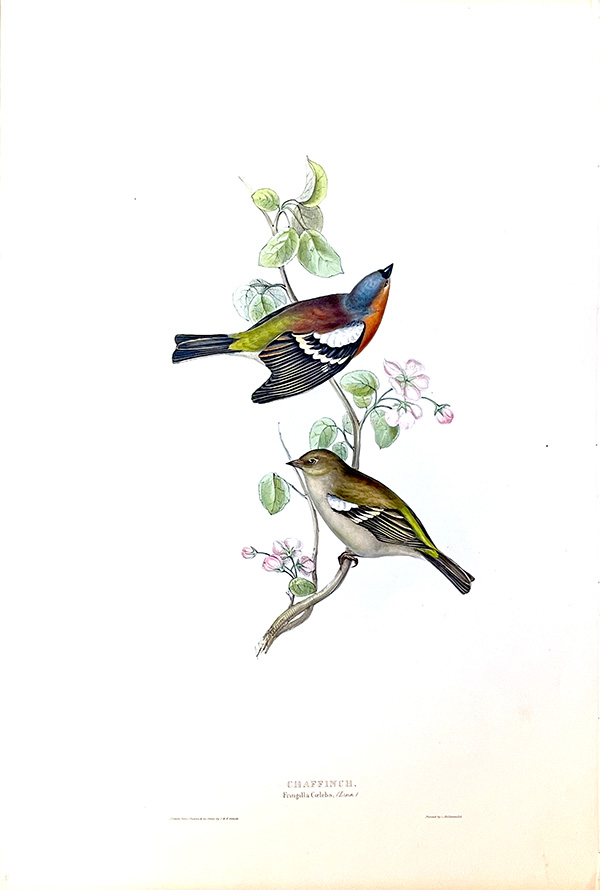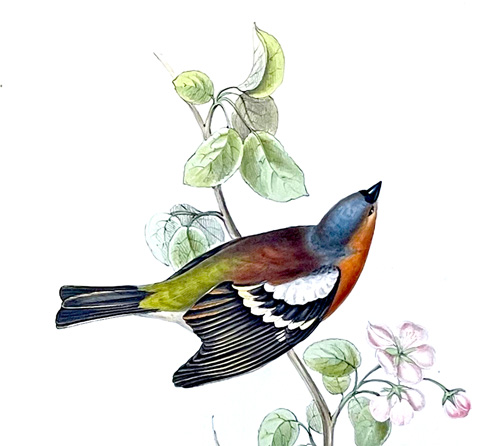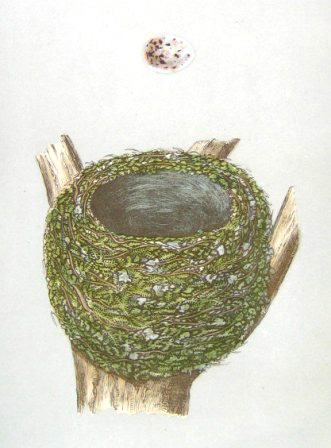


Chaffinch from John Gould's Birds of Europe, 1832–37.
I have been delighted this spring by a rosy breasted chaffinch and his mate, which have made themselves at home in the backyard here.
I noticed him first, the rosy breasted male, proclaiming his territory from the very top twig of the avocado tree. With the head thrown back and the throat swelling with ecstasy, he was trying to give power to his rather small sweet song as he attempted to match the rich song of a blackbird across the way, and attract a female. The ornithologist, Oliver, has given a description of the chaffinch’s song as usually heard in New Zealand “as a bar of seven notes and terminal flourish.” It was not long before he was giving chase to a female which one might mistake for a sparrow if not for the white wing bar. I wonder if she is perhaps more attracted to the sheltered territory he has claimed than his beautiful but subdued colours and sweet song.
The pair are here every day now scavenging for food. They feed on insects fruit and seeds but here they are particularly interested in the scraps left from food given to my dog, the odd crumb or two that he leaves. They mainly feed on the ground, hopping about among the sparrows but unlike them they rarely hawk for insects. I would hazard that he and his mate have nested in the patch of manuka in the reserve beyond the back fence while his rival in song, the blackbird, has claimed the most wonderful bower in the red flowering rata growing over the ponga hut.
The books tell me that the nest is a compact deep cup made from dried grass and decorated on the outside by lichen and moss and inside lined with feathers. It is the female that builds the nest that takes from 3 to 18 days to complete, the lesser time going to the older more experienced birds as one might expect. She also does most of the feeding of the young. The parents eat the faeces of the young for the first few days and then carry them away from the nest. In New Zealand, unlike in Europe, the pair may brood a second time and if both parents survive to the following year, they will probably pair again.
The chaffinch, according to Oliver, was introduced into New Zealand as early as 1862 and liberated near Nelson. Subsequently, it was released in many parts of New Zealand by private individuals and acclimatisation societies, the forerunners to the modern Fish and Game Councils. It is one of four finches introduced here, a species of which there are 153 worldwide, none of which are native to Australia and New Zealand. They are characterised by their short, stout, conical bills and powerful gizzards for breaking up seeds. The distribution of the chaffinch in the northern hemisphere is widespread; in Europe, north almost to the tree limit and south to North Africa and Iran, east into Siberia and West to the Canaries, Azores, Madeira and Cape Verde Islands. Most northeastern birds winter in the southwest.
Although northern populations of chaffinches in Europe are migratory there is no evidence of regular migration here although they flock in winter, often with other finches, and congregate in orchards.
I think it is quite remarkable that our native and endemic birds, with some exceptions, shun the settled areas, while the introduced birds by and large shun the dense bush. One of the exceptions is the chaffinch. They are equally at home in city parks and gardens, farmland, orchards and scrub as well as the bush from sea to subalpine levels.
Narena Olliver — Ohiwa Beach, 2000.


Close-up of male Chaffinch from John Gould's Birds of Europe, 1832–37.
| Taxonomy | |
|---|---|
| Kingdom: | Animalia |
| Phylum: | Chordata |
| Class: | Aves |
| Order: | Passeriformes |
| Family: | Fringillidae |
| Genera: | Fringilla |
| Species: | coelebs |
| Sub Species: |
shilfa, scobby, shelly, skelly, shell-apple, beech-finch, twink, spink, pink.
Introduced bird
15 cm; male 22 g, female 21 g. Sparrow-sized finch with white shoulder, wingbar and outer tail feathers. Adult male has black forehead, blue-grey crown and nape; rich pinkish-brown face and underparts, fading to white on belly; reddish-brown back; greenish rump. Female and juvenile lack male colours; brownish grey, except greenish rump and prominent white wingbars on darker wing.
Widespread and common.
Poetry: —
Tis spring, warm glows the south,
Chaffinch carries the moss in his mouth
To filbert hedges all day long,
And charms the poet with his beautiful song;
— John Clare

Chaffinch nest from the Reverend F.O. Morris' A Natural History of the Nests and Eggs of British Birds, 1863.
Gould, John, Birds of Europe, 1832–37.
Morris, Reverend F.O., A Natural History of the Nests and Eggs of British Birds, 1863.
Heather, B., & Robertson, H., Field Guide to the Birds of New Zealand, 2000.
Oliver, W.R.B., New Zealand Birds, 1955.
Friday, 1 September, 2023; ver2023v1